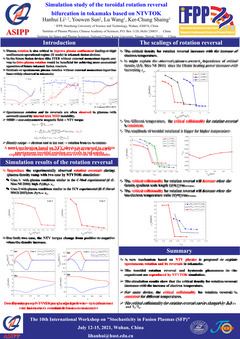Symmetry breaking driving spontaneous plasma rotation in tokamak fusion devices
ID:9
View Protection:PUBLIC
Updated Time:2021-07-13 08:16:19
Hits:1201
Poster Presentation

Start Time:2021-07-12 09:20 (Asia/Shanghai)
Duration:20min
Session:[E] E-poster » [E] E-poster
Abstract
Plasma rotation plays a critical role in improving plasma confinement in a magnetically confined fusion device. Spontaneous plasma rotation and its reversal of orientation without external momentum input have been observed in some tokamak fusion devices, while the underline physics is not well understood. A new mechanism based on NTV physics is proposed to explain spontaneous rotation and its reversals in tokamaks. Toroidal rotation reversal is achieved, when the steady state rotation jumps between ion root and electron root determined by the NTV torque in low collisionality plasmas. Modeling results using the NTVTOK code well reproduce the main features of experimentally observed rotation reversals during plasma density ramp with assumed 1 cm non-axisymmetric displacement caused by internal kink mode. The magnitude of NTV torque is big enough to change the toroidal rotation and the magnitude of rotation profile in core is comparable with the experiment observations. The nonlinear hysteresis process of plasma rotation reversals is also well reproduced in the modeling. As the NTV effect enhances with decreasing plasma collisionality i.e. increasing of machine size and performance, it may play a critical role in driving flows in future tokamak fusion reactors. The mechanism for driving spontaneous plasma rotation proposed in this paper may be utilized for achieving more economical operation of future fusion reactors.
Keywords
spontaneous rotation, neoclassical transport, NTV physics, NTVTOK code
Speaker

Comment submit